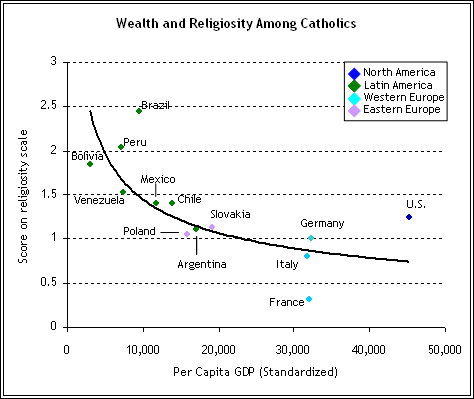by Richard Wike, Associate Director and Kathleen Holzwart, Research Analyst, Pew Global Attitudes Project
As he tours Washington and New York on his first visit to the United States since ascending to the papacy, Pope Benedict XVI will be greeted by a Catholic population that, while undergoing rapid ethnic and demographic changes within itself,1 continues to occupy a unique spot in the global Catholic community. Generally less religious than their fellow Catholics in the developing world, and generally more religious than those in Europe, American Catholics occupy something of a middle ground in a faith that is often pulled in opposing directions by its diverse constituencies across the globe.
Comparing Catholics Around the World
Rome may remain the organizational and symbolic hub of Catholicism, but in many ways the center of the faith has been gravitating southward for decades. As Europeans increasingly turn away from the Church, religious commitment remains relatively strong among Catholics in regions such as Latin America. The 2007 Pew Global Attitudes survey explored religious views around the world, and the findings shed some light on the sharp differences among followers of Catholicism. Faith plays a much more central role in the lives of Latin American Catholics than among those from Europe. Meanwhile, American Catholics stand squarely in the center.
In order to compare the religiosity of Catholic publics in Europe, Latin America, and the U.S., we constructed an index based on three questions: whether faith in God is necessary for living a moral life, the importance of religion in respondents’ lives, and a how often respondents pray.2 The scale ranges from “0,” the least religious position, to “3,” the most religious position. Among the 13 nations included in the analysis, Brazilian Catholics have the highest religiosity score (2.45), and the top six spots all belong to Latin American countries.
Western European Catholics are the least religious, especially the French (.33), although scores are also relatively low in Germany (1.01), birthplace of Pope Benedict, and Italy (.81), birthplace of more popes than any other country. Catholics from the Eastern European nations of Poland and Slovakia have somewhat higher scores than their Western European co-religionists, but about the same as Argentina, the outlier among Latin American nations.
 American Catholics (1.26) are right in the middle — six countries have higher scores than the U.S. and six have lower scores. On this measure, American Catholics are more religious than all five European countries, including Poland, a country known for its strong commitment to Catholicism and home to former Pope John Paul II. Meanwhile, the U.S. has a lower score than six of the seven Latin American countries.
American Catholics (1.26) are right in the middle — six countries have higher scores than the U.S. and six have lower scores. On this measure, American Catholics are more religious than all five European countries, including Poland, a country known for its strong commitment to Catholicism and home to former Pope John Paul II. Meanwhile, the U.S. has a lower score than six of the seven Latin American countries.
Moreover, on each of the three items that comprise the scale, American Catholics also stand near the center of global Catholic opinion. About half of Catholics in the U.S. think it is necessary to believe in God in order to be a moral person, pray at least once a day, and say religion is very important in their lives.
Brazilian Catholics emerge as the most religious on all three measures, while Italy and France have the least religious Catholic populations. Only 17% of French Catholics say faith is necessary for morality; 13% pray a least once per day; and just 12% consider religion very important to their life.
Wealth and Religion
Previous analyses of the Pew data highlighted the strong relationship between a country’s level of wealth and its level of religiosity — in general, richer countries are less religious.3 And, as the chart below illustrates, this same pattern holds true when looking only at Catholic populations. In the 13 countries included in this analysis, there is a strong negative correlation (-.66) between a country’s wealth (measured by purchasing power parity) and the degree of religiosity among its Catholics.
Latin American Catholics tend to cluster in the upper left of the chart, indicating their low levels of wealth and high levels of religiosity, while those in Western Europe show up in the lower right as the result of their prosperity and lower scores on the religiosity index. Most countries appear in the chart about where their stage of economic development would predict. For example, on this chart, Argentina does not look like an outlier; instead, it falls precisely where it should given its comparative wealth in relation to other Latin American nations.
Still, there are a few countries that do not closely fit the pattern. Brazilian Catholics are somewhat more religious than their national income would lead you to expect, while the French are even less religious than their comparative prosperity would predict. But the biggest outlier is the United States. American Catholics live in a country that is significantly wealthier than even the economically advanced nations of Western Europe, so in theory the U.S. should appear near the bottom right of this chart. Instead, the U.S. occupies a unique space, the only Catholics in the study who are both wealthy and religious.
In this way, American Catholics are a lot like other Americans, who also tend to be more religious than the country’s affluence would predict. The enduring centrality of religion in American life sets this country apart from many other economically advanced nations, particularly those in Western Europe. On many issues, Americans continue to share values with their traditional transatlantic allies, but when it comes to matters of faith, Americans — including American Catholics — often have more in common with those outside of Europe.


